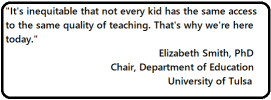Over the last year, many of our subscribing districts requested reviews of adaptive materials. The concept behind adaptive materials is admirable: different content is presented to each student based upon the student’s performance on each task or assessment. In essence, these products offer the promise of an individualized instruction for each student.

However, districts should not assume that “adaptive” means “aligned to standards.” Many adaptive materials assign content based on skill mastery rather than mastery of the standards. Based on our experience, districts would be advised to carefully review the alignment of adaptive materials to the standards they are needed to support before using them.

